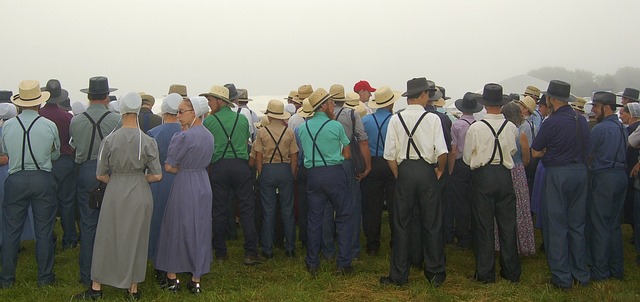The Amish and the English refer to two distinct cultural groups that have significant differences in their way of life, beliefs, and values. The Amish are a religious community known for their strict adherence to traditional practices and rejection of modern technology, while the term “English” is often used by the Amish to refer to those outside their community who embrace mainstream American culture. This introduction sets the stage for exploring the contrasting characteristics and lifestyles of the Amish and the English.
Table of Contents
Cultural Differences between the Amish and English Communities
The Amish and English communities are two distinct groups that coexist in many parts of the United States. While they may live side by side, their cultural differences are quite pronounced. These differences can be seen in various aspects of their lives, including their beliefs, values, and way of life.
One of the most noticeable differences between the Amish and English communities is their approach to technology. The Amish, known for their simplicity and rejection of modern conveniences, shun most forms of technology. They believe that excessive use of technology can lead to a loss of community and a weakening of their faith. As a result, you won’t find Amish individuals using smartphones, driving cars, or even using electricity in their homes. In contrast, the English community embraces technology and relies heavily on it for communication, transportation, and entertainment.
Another significant difference between the Amish and English communities is their dress code. The Amish are known for their traditional clothing, which is simple, modest, and often handmade. Men typically wear plain shirts, suspenders, and broad-brimmed hats, while women wear long dresses, aprons, and bonnets. This attire reflects their commitment to humility and separation from the world. On the other hand, the English community follows contemporary fashion trends and wears clothing that is more diverse and expressive of individual style.
Religion plays a central role in both the Amish and English communities, but their religious practices differ significantly. The Amish are a deeply religious group that follows a strict interpretation of the Bible. They prioritize community worship and live according to a set of rules known as the Ordnung. The Ordnung governs all aspects of Amish life, including dress, behavior, and social interactions. In contrast, the English community is more diverse in terms of religious beliefs and practices. While many English individuals identify as Christians, they have a wide range of denominations and levels of religious observance.
Education is another area where the Amish and English communities diverge. The Amish prioritize practical skills and value hands-on learning. They typically attend one-room schoolhouses until the eighth grade, where they learn basic reading, writing, and arithmetic. After completing their formal education, they focus on learning skills that are essential for their agricultural lifestyle, such as farming and carpentry. In contrast, the English community places a strong emphasis on formal education and encourages individuals to pursue higher education to expand their knowledge and career opportunities.
Despite these differences, the Amish and English communities often find ways to coexist and interact with one another. Many English individuals are fascinated by the Amish way of life and visit Amish communities to learn about their traditions and values. Likewise, the Amish recognize the importance of engaging with the broader society and often interact with their English neighbors for business or other necessary purposes.
In conclusion, the cultural differences between the Amish and English communities are evident in their approach to technology, dress, religion, and education. While the Amish prioritize simplicity, modesty, and community, the English community embraces technology, individual expression, and diversity. Despite these differences, both communities find ways to coexist and learn from one another, fostering a sense of mutual respect and understanding.
Traditional Amish Lifestyle versus Modern English Lifestyle

Amish Vs English: Traditional Amish Lifestyle versus Modern English Lifestyle
Have you ever wondered what it would be like to live a simpler, more traditional lifestyle? In today’s fast-paced world, many people are seeking a break from the hustle and bustle of modern life. One group that has managed to maintain a traditional way of life is the Amish community. Let’s take a closer look at the differences between the Amish and the English, as they refer to those outside their community.
The Amish, known for their distinctive dress and horse-drawn buggies, live a lifestyle that is deeply rooted in tradition. They value simplicity, hard work, and close-knit communities. In contrast, the English, as the Amish refer to those outside their community, embrace modern conveniences and a more individualistic way of life.
One of the most noticeable differences between the Amish and the English is their approach to technology. While the English rely heavily on technology for communication, transportation, and entertainment, the Amish shun most modern inventions. They believe that excessive use of technology can lead to a loss of community and a weakening of their faith. Instead, the Amish prefer to rely on traditional methods of transportation, such as horse and buggy, and they avoid using electricity in their homes.
Another significant difference between the Amish and the English is their approach to education. The Amish prioritize practical skills and hands-on learning, while the English place a greater emphasis on formal education. Amish children attend one-room schoolhouses where they learn basic reading, writing, and arithmetic. After completing their education, they focus on learning practical skills that will be useful within their community. In contrast, the English value higher education and encourage their children to pursue college degrees and professional careers.
The Amish also have a unique approach to healthcare. They rely on natural remedies and homeopathic treatments rather than modern medicine. The Amish believe in the healing power of nature and prefer to use herbs, essential oils, and other natural remedies to treat illnesses. In contrast, the English rely on doctors, hospitals, and prescription medications for their healthcare needs.
Despite these differences, the Amish and the English share some common values. Both groups value hard work and self-sufficiency. The Amish are known for their strong work ethic and their commitment to providing for their families. They believe in the importance of manual labor and take pride in their ability to produce their own food, clothing, and other necessities. Similarly, many English individuals also value hard work and strive for success in their careers.
In conclusion, the Amish and the English lead very different lifestyles. The Amish embrace tradition, simplicity, and close-knit communities, while the English embrace modern conveniences and a more individualistic way of life. Despite these differences, both groups share common values such as hard work and self-sufficiency. Whether you prefer the simplicity of the Amish lifestyle or the convenience of modern technology, it’s important to respect and appreciate the choices made by others. After all, diversity is what makes our world so interesting and vibrant.
Education and Technology: Contrasting Approaches of the Amish and English
When it comes to education and technology, the Amish and the English have contrasting approaches. The Amish, known for their traditional way of life, place a strong emphasis on practical skills and hands-on learning. They believe that education should prepare children for their future roles within the community, rather than focusing on academic achievement. On the other hand, the English, or non-Amish, prioritize formal education and embrace technology as a tool for learning and advancement.
The Amish education system is centered around the values of simplicity, humility, and community. Amish children attend one-room schoolhouses, where they are taught by a single teacher who is typically a member of the community. The curriculum focuses on basic subjects such as reading, writing, and arithmetic, with an emphasis on practical skills like farming, woodworking, and homemaking. The goal is to equip children with the skills they will need to contribute to the Amish way of life and to ensure the survival of their community.
In contrast, the English education system places a strong emphasis on academic achievement and preparing students for higher education and professional careers. English children attend public or private schools, where they are taught by certified teachers who follow a standardized curriculum. The curriculum includes a wide range of subjects, from math and science to literature and history. English students are encouraged to pursue higher education and are provided with resources and opportunities to explore their interests and talents.
Technology is another area where the Amish and the English differ greatly. The Amish have a strict aversion to modern technology, believing that it can lead to worldly temptations and a loss of community values. They reject electricity, televisions, computers, and the internet, viewing them as distractions from their simple way of life. Instead, the Amish rely on traditional methods and tools to meet their needs, such as horse-drawn carriages, oil lamps, and manual labor.
In contrast, the English embrace technology as a tool for learning and advancement. Computers, tablets, and the internet are integrated into classrooms, providing students with access to a wealth of information and resources. Technology is seen as a way to enhance education, allowing students to engage in interactive learning experiences and connect with people from around the world. It also prepares them for the digital age and the technological demands of the modern workforce.
While the Amish and the English have different approaches to education and technology, both have their merits. The Amish focus on practical skills and community values, ensuring the preservation of their way of life. Their education system prepares children for a life of self-sufficiency and emphasizes the importance of strong family and community ties. On the other hand, the English education system prepares students for higher education and professional careers, equipping them with the knowledge and skills needed to succeed in a rapidly changing world.
In conclusion, the Amish and the English have contrasting approaches to education and technology. The Amish prioritize practical skills and hands-on learning, while the English prioritize academic achievement and embrace technology as a tool for learning and advancement. Both approaches have their merits and contribute to the unique cultures and values of these two communities.
Religious Beliefs and Practices: A Comparison of Amish and English Faith
Amish Vs English: Religious Beliefs and Practices
When it comes to religious beliefs and practices, the Amish and the English have stark differences. The Amish, known for their simple and traditional way of life, adhere to a strict set of religious principles that guide their every action. On the other hand, the English, or non-Amish, have a more diverse range of religious beliefs and practices. In this article, we will explore the key differences between the Amish and the English in terms of their religious beliefs and practices.
One of the most notable differences between the Amish and the English is their approach to technology. The Amish believe in living a simple life, free from the distractions and temptations of modern technology. They view technology as a threat to their community and believe that it can lead to a loss of faith and a breakdown of their traditional way of life. As a result, the Amish reject most forms of technology, including electricity, cars, and telephones. Instead, they rely on traditional methods of transportation, such as horse and buggy, and use oil lamps for lighting.
In contrast, the English embrace technology and see it as a tool to enhance their lives. They use electricity, drive cars, and have access to modern conveniences such as smartphones and computers. While some English individuals may have religious beliefs that discourage certain uses of technology, such as excessive screen time or the use of social media, these beliefs are not as widespread or strictly enforced as in the Amish community.
Another significant difference between the Amish and the English is their approach to education. The Amish believe in providing their children with a practical education that prepares them for a life of manual labor and self-sufficiency. They emphasize the importance of learning skills such as farming, woodworking, and homemaking. Formal education beyond the eighth grade is discouraged, as it is seen as unnecessary and potentially harmful to their way of life.
In contrast, the English place a high value on formal education and encourage their children to pursue higher education and professional careers. They believe that education is essential for personal growth and success in the modern world. The English have access to a wide range of educational opportunities, from public schools to universities, and they encourage their children to explore their interests and pursue their passions.
Religious worship is another area where the Amish and the English differ. The Amish worship in small, close-knit communities known as church districts. They gather for worship services in their homes or in simple meetinghouses, where they sing hymns, listen to sermons, and engage in communal prayer. The Amish also place a strong emphasis on community and regularly come together for social events and celebrations.
In contrast, the English have a more diverse range of religious practices. Some may attend traditional church services, while others may practice their faith in less formal settings or even in the privacy of their own homes. The English have the freedom to choose their own religious beliefs and practices, and they often participate in a variety of religious and spiritual activities.
In conclusion, the Amish and the English have distinct differences in their religious beliefs and practices. The Amish prioritize simplicity, reject technology, and emphasize practical education and community worship. The English, on the other hand, embrace technology, value formal education, and have a more diverse range of religious practices. Despite these differences, both groups share a common desire to live meaningful and fulfilling lives guided by their faith.
Conclusion
In conclusion, the Amish and English communities have distinct lifestyles and beliefs that set them apart. The Amish prioritize simplicity, community, and adherence to traditional values, while the English embrace modernity, individualism, and technological advancements. Despite their differences, both communities contribute to the diversity and richness of society.
For licensing reasons, we must provide the following notice: This content was created in part with the help of an AI.


